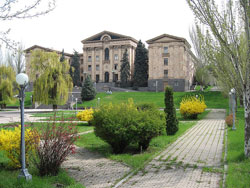Yerevan, Armenia

Yerevan is the modern capital of Armenia and one of the most interesting cities in the Caucasus. There are many legends associated with the name of the city, and one of them tells that Noah, during the Flood, saw dry land in the place where Yerevan is now located and exclaimed: “Yerevants!” (which in Armenian means “She appeared!”) is where, according to legend, the name of Yerevan comes from. According to another version, it is believed that the city was named after the Armenian king Yerevand IV, the last representative of the Orontid dynasty and the founder of the city of Yervandashat. However, it is more likely that it comes from the name of the Urartian military fortress of Erebuni, which was built on the territory of modern Yerevan in 782 BC.
Today Yerevan is a city in which a variety of architectural styles are found, with green alleys, numerous fountains, with a large number of theaters, museums, shops and restaurants. But the most amazing thing in Yerevan is people with an unusual, proud Caucasian appearance, expressive black eyebrows and eyes, friendly faces, hospitably ready to welcome anyone who comes to see the beauty of the city or is interested in Armenian culture.
Geographical location
Yerevan is located on an area of 300 square meters. km., in the northeastern part of the Ararat Plain, in the central part of the Armenian Highlands.
Climate
The climate is temperate continental, arid. Summers are hot and dry, winters are mild and with little snow. Autumn is sunny and long, with warm weather until mid-November. Spring is short, starting in March, and hot summer lasts more than 4 months. Tours to Armenia It's best to plan for late spring or early fall.
Population of Yerevan
The population of Yerevan is 1.356 million inhabitants. Before the collapse of the Soviet Union, the majority of Yerevan's population were Armenians, as well as Russians, Kurds, Azerbaijanis and Iranians. Today, the national composition of Armenia is the most homogeneous among all the former Soviet republics: 95.66% of its population are Armenians: Russians, Ukrainians, Kurds, Greeks, and Assyrians also live in the republic.
Industry
Yerevan is the industrial center of the country; numerous industrial enterprises are located here, 98% of which were created after 1917. Industrial output in 1970 increased 30 times compared to 1940. The city is also a central energy hub, where the bulk of the republic's electricity is generated. The main industries represented here are: mechanical engineering and metalworking, chemical and petrochemical, food, light industry.
Architecture of Yerevan
The architecture of Yerevan is unique and diverse; here you can see both modern buildings and unique historical monuments, evidence of the ancient past of the city. The architectural center of new Yerevan is Republic Square. It houses two Government Houses, the Historical Museum of Armenia, the world's largest institute, the Matenadaran museum-repository of ancient Armenian manuscripts, the Opera and Ballet Theater with the Great Hall of the Philharmonic named after. Aram Khachaturyan. The project and layout of this theater were presented at the 1936 World Exhibition in Paris, where they received the Grand Prix. In 1968, the Erebuni Museum was opened, dedicated to the history of Erebuni and Teishebaini. In Yerevan, one of the oldest cities in the world, many architectural monuments of antiquity have been preserved, including the ruins of a Roman fortress, a Turkish fort of the 16th century and a mosque of the 18th century, the churches of Katoghike (XIII century) and Zoravar (XVII-XVIII centuries).

History of Yerevan
The first mentions of Yerevan are found in historical literature of the 6th century. Archaeological excavations and cuneiform inscriptions indicate that modern Yerevan arose near the Erebuni fortress, which was built by the Urartian king Argishti I in 782 BC. uh, presumably this is where the name of the city comes from. Since the mid-13th century, the role of Yerevan as a political and economic center has increased due to the emergence of caravan routes that pass through Yerevan.